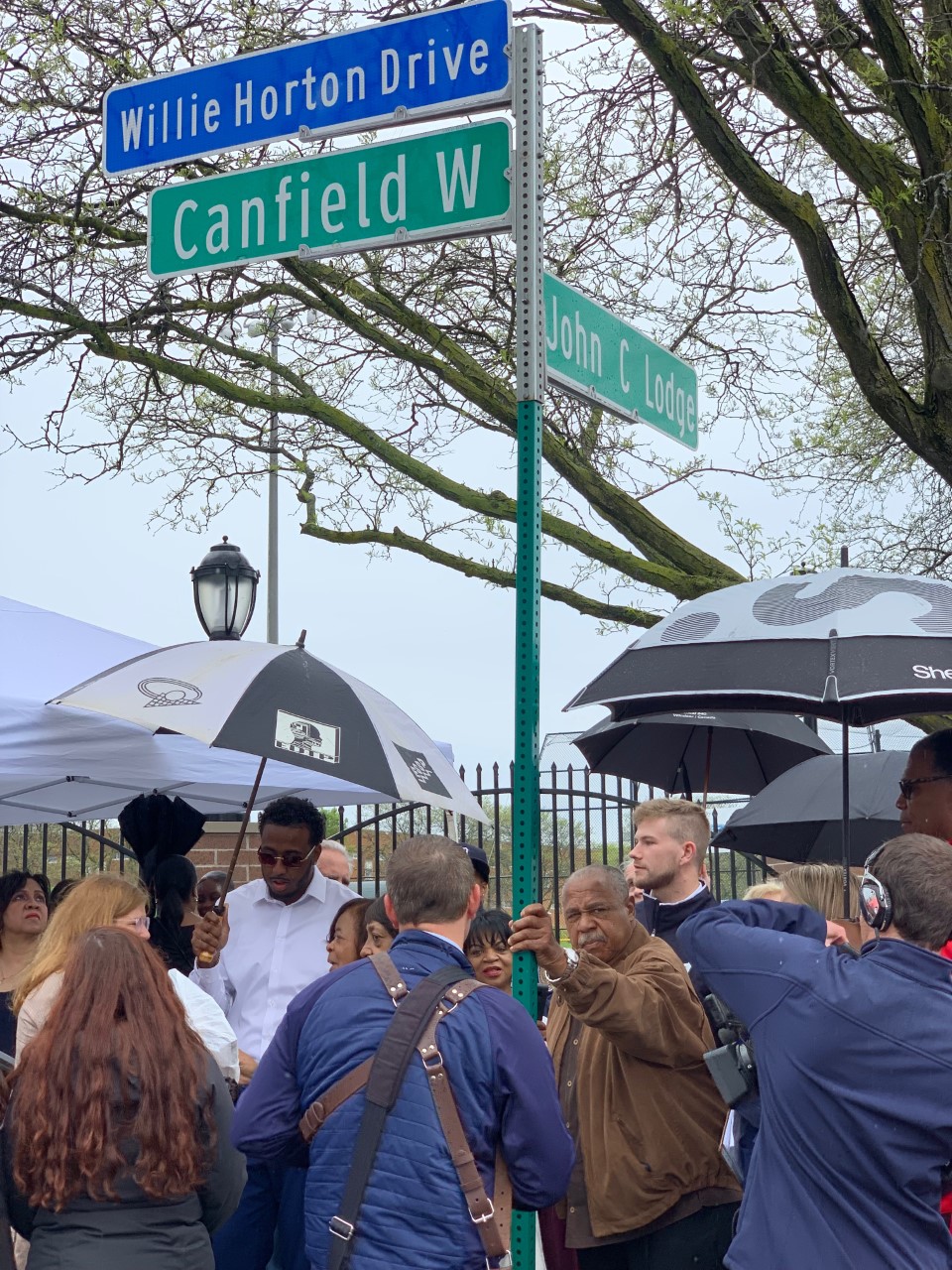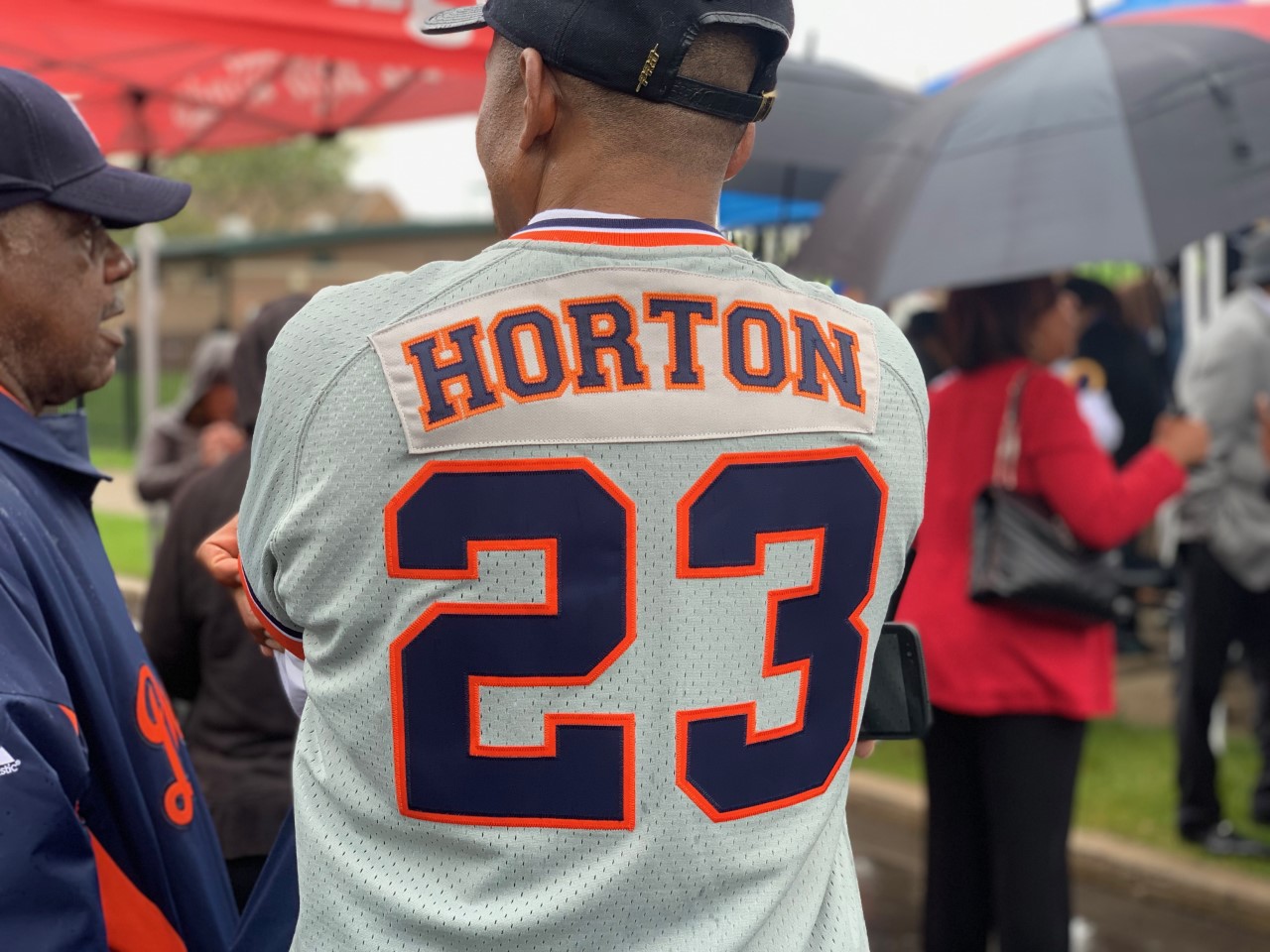There was not going to be a rain delay and the tarp did not need to be brought out on Willie Horton’s special day. The former Detroit Tigers slugger was not going to let the pouring rain put a damper on the renaming of the intersection of West Canfield Avenue and the John C. Lodge Service Drive in honor of him.
Detroit City Council members passed the resolution during their regular meeting May 14 to have “Willie Horton Drive” as the secondary name of the street, complete with a blue sign installed by city worker Claude Singleton.
Horton, 76, was joined by his family, Chairman and CEO of the Detroit Tigers, Chris Illitch, Mayor Mike Duggan, City Council president Brenda Jones, former Tigers pitcher Jack Morris, current outfielder Christin Stewart,Tigers general manager Al Avila, and a host of family, friends, and fans.
“I never envisioned that this day would come,” said Horton, who played baseball at the nearby park as a child at former Poe Elementary. “This is where it started for me out on this field and I hope some more Willie Hortons will come from the neighborhood and this field.”

Before they were demolished in 2001, the Jeffries Housing Projects were where Horton grew up in the 1950s. They were named after Judge Edward J. Jeffries Sr., who died in 1939 and was the father of former Detroit mayor Edward J. Jeffries Jr. The massive public housing project consisted of 13 high-rise buildings and 415 low-rise units between both the Jeffries West and Jeffries East Housing Projects.
Horton grew up in the 14-story Jeffries West Housing Projects.
“I grew up in about the fifth building down at 1002 (West Canfield),” said Horton. “We lived in the high-rises and we called it the penthouse.”
Horton’s legend on the baseball diamond started as a student at nearby Northwestern High School, where he won a Detroit Public School League (PSL) city title in 1959 with teammate Matt Snorton who played pro football, coached by Hall of Famer Sam Bishop. He was known to hit the ball onto Grand River during high school games, but his biggest blast came when he hit a home run out of Briggs Stadium (Tiger Stadium) at the age of 16 during the PSL championship game between Cass Tech and Northwestern.
Two years later, he would leave Northwestern early to sign with the hometown Tigers in 1961. Horton played 18 years in the major leagues, 15 of those in Detroit where he was a four-time All-Star and was instrumental in the Tigers’ 1968 World Series win. He hit 325 home runs with 1,163 RBIs, and batted .273 during his major league career, which also included stops in Seattle, Oakland, Texas, Cleveland and Toronto. There is also a statue of Horton located inside Comerica Park and his No. 23 was retired in 2000.
“It is truly fitting that we are able to recognize Willie right here in the neighborhood where he grew up,” said Ilitch, who called Horton one of the greatest Tigers of all-time. “Having the name Willie Horton grace this street will ensure all who live or travel through this area will be reminded of Willie’s significance to Detroit for generations to come.
“It would’ve been wonderful if my dad would’ve also been here today. He would have loved to celebrate this great honor with Willie and his family. He was a big Willie Horton fan.”

In game five of the 1968 World Series, facing elimination, Horton threw a strike from left field to get the speedy Lou Brock out at home plate. Detroit went on to win the game 5-3 and the series. Mayor Duggan was only 10-years-old at the time, but recalled his own favorite memory of Horton during the summer of 1976.
“Mark Fidrych was pitching against Gaylord Perry of the Texas Rangers, a Hall of Famer, and Willie hadn’t played that day,” recalled Duggan. “Willie led off the ninth inning and he hit a ball into the left field seats for a home run. The fans cheered, the game was over, and the players left. The fans stayed in the stands chanting over and over, ‘We want Willie,’ until he came back out of the dugout.
“And nobody stood and cheered louder and longer than I did, because I thought as a fan in the center field bleachers in 1976 that was going to be the only way I could ever say thank you to Willie Horton for all he meant to me. So, it’s an enormous honor to be here on Canfield to be able to thank him in a much more permanent way.”

Horton, who is the youngest of James and Lillian Horton’s 21 children, credited a number of people for his success on and off the baseball field. One of those people was late federal judge Damon J. Keith, who became a father figure to Horton when his parents died in a car crash January 1, 1965.
“At a young age, Judge Keith taught me to keep your ears open, your mouth shut, and you’ll learn something,” said Horton.
The street naming is not the first honor in the city of Detroit for Horton. October 18, his birthday, is “Willie Horton Day” in Michigan; old Tiger Stadium is now named the “Willie Horton Field of Dreams”; and Northwestern High School named its baseball and softball fields in honor of Horton. City Council president Jones also presented him with a resolution at the ceremony, along with council members Andre Spivey and Scott Benson.
“Willie is truly my hero and has been my hero for a long time,” said Jones. “Willie, I love you so much. This could not happen to a better person.”